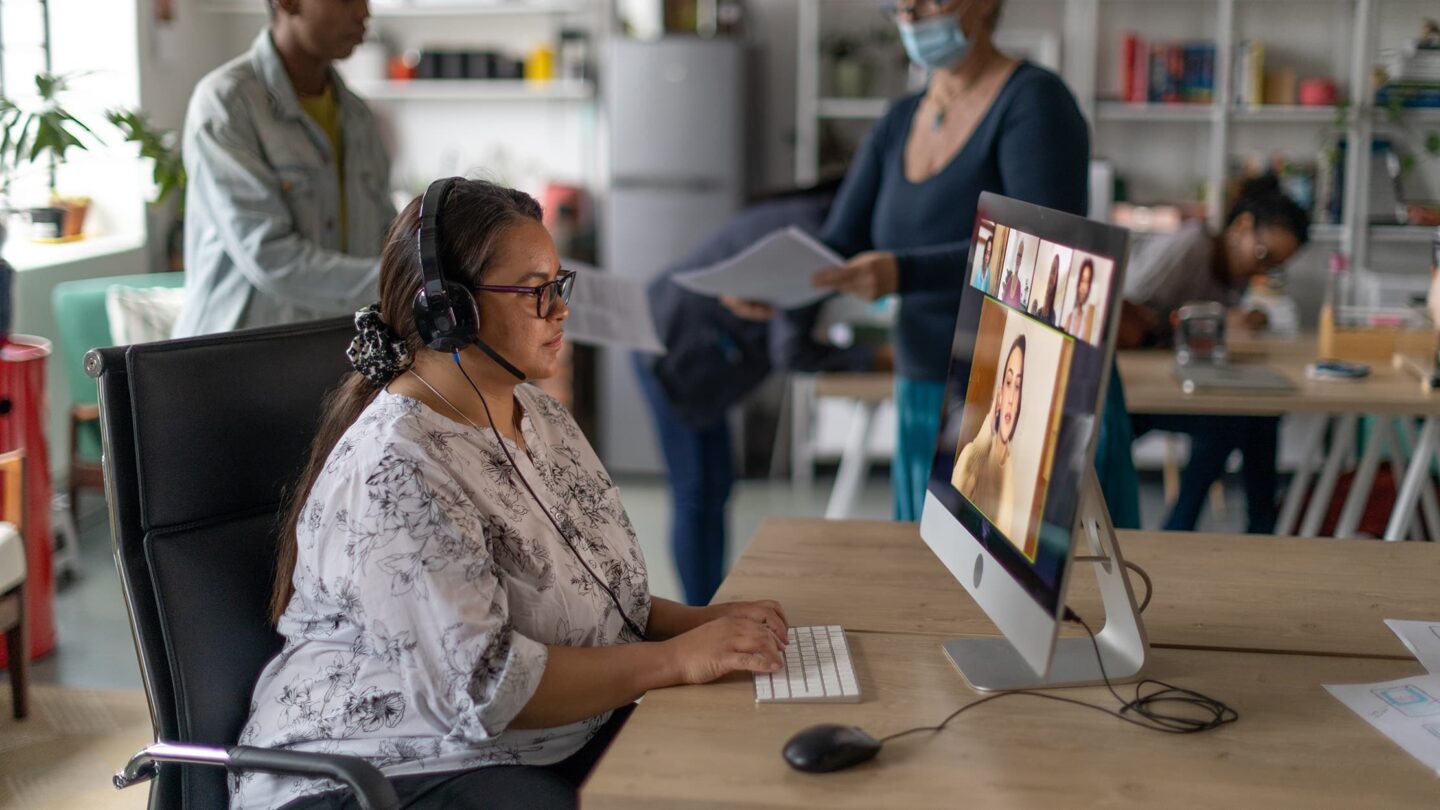People & Leadership
How work and employee expectations are changing post-pandemic
Employee expectations are evolving after the pandemic changed the way we work. See how to adapt your business to new ways of doing things.

Employee expectations are rapidly evolving due to the ways the pandemic has changed the way we work.
Businesses that respond to these changes will be best equipped to recruit and retain talent.
But how should business leaders respond to this new world of work? How can you ensure you meet the needs and satisfy the wishes of your employees?
Here’s what we cover in this article:
The impact of digital transformation
Alongside, technology continues to revolutionise the way we work.
“As digitalisation disrupts society ever more profoundly, concern is growing about how it is affecting issues such as jobs, wages, inequality, health, resource efficiency and security,” notes the World Economic Forum (WEF) in a recent post.
Digital transformation has changed operations, products and services, for example, while Robotic Process Automation (RPA) and artificial intelligence (AI) mean roles are changing for employees.
Ideally, this technology should free them up to focus on work that adds value to the business, for example by developing better relationships with colleagues, customers and suppliers as machines perform an increasing amount of repetitive, manual work.
Business leaders need to ensure they’re ready for this transformation.
As the WEF observes: “With both winners and losers resulting from digital transformation, a huge premium rests on the near-term ability of businesses to upskill employees and shape the next generation of talent for the machine age.”
Meeting employee expectations
Here are six areas relating to employee expectations that all business leaders need to consider:
1. Mobility
Workers now expect to be able to work remotely, with the ability to decide themselves how to match work to the right setting. Many of us expect to be able to work from home or while we’re travelling for business or even for holidays.
How well equipped is your business to allow your people to do this?
Having the right technology in place to facilitate meetings on days when some employees are out of the workplace and enabling them to access information and your organisation’s databases is essential.
Providing a range of videoconferencing tech such as Zoom, Microsoft Teams and Google Meet, and ensuring your employees are familiar with them is important. This also means that as well as knowing how the systems work technically, they’re aware of good virtual meetings etiquette.
This includes checking their background, ensuring they won’t be disturbed, looking into the camera rather than at the screen when talking and making sure that they’re properly lit.
And on that point, there’s probably a wider debate to be had around when cameras should be on during online meetings, and when they can be left off. Working with your employees to come up with a consensus on this will allow your people to show up in the right way during their virtual meetings.
Not only do these small things help to improve your organisation’s image in external meetings but they encourage employees to up their game in terms of their professionalism, presentation and energy, even if they’re working at home.
Cloud computing means that instead of storing information in your ‘on premise’ IT systems, many of the files that your people need can be available to them wherever they’re working.
It’s more secure than it used to be, and you can set up security protocols to protect your most sensitive data.
2. Choice
Avoiding a commute five days a week, having the ability to take the dog for a walk or pick up the children from school around meetings and periods of work at our desk appeals to many.
More of us than ever expect to have the choice to work from home if it suits us.
According to a poll by EY, more than half (54%) of employees around the world would consider leaving their job if they were not offered some form of flexibility in where and when they work.
Nine out of 10 respondents said they wanted flexibility of timing and location of their work, with millennials twice as likely to quit as baby boomers.
“Employees are seeking flexibility and a healthy work/life balance, and rightly so,” says Sarah Towers, consulting director at business change consultancy Entec Si.
“With it currently being an employee market, the control is very much in the hands of the worker, and many are actively seeking remote or hybrid opportunities.
“Employers who aren’t offering this kind of choice, or acknowledging how their talent wants to work, will soon be left behind.”
You need to think about how you empower your people to make their own decisions about where and when they work.
Do they feel trusted to make these choices, safe in the knowledge that as long as they meet their targets, deliver on their goals and collaborate well with colleagues, they have the leeway to choose how, where and when they work and that they’ll be supported by their managers to do so?
When should staff come into the workplace?
It’s important to consider how you’re going to arrange meetings so employees who choose to work from home still have some time together with colleagues in person.
A growing number of businesses are accepting that staff might write reports or carry out similar tasks at home but then they can choose to come into the office setting for meetings, team-bonding sessions and activities such as appraisals on certain days.
Coordinating timetables is important.
“We’ve chosen to have one day where the whole company is required to be in the office,” says Alia Al-Doori, managing director at PR agency Pearl Comms.
“We use this day for planning, brainstorming, catching up, building bonds and the like.
“This day also ensures that there is regular communication and allows managers to check in easily with other teammates. We also do 1-2-1s and progress updates on the days when we’re in together.
“As a manager, trusting the team to know what works best for them and their schedule is important.
“Giving employees the freedom to make these decisions helps increase productivity, improve happiness and ensure that work also fits around the commitments in their personal lives.”
3. Privacy
Many workers struggled to find privacy in the workplace as they expect to maintain the privacy they have become accustomed to at home.
Just when they got used to working in the familiar surroundings of their own living room, kitchen or bedroom, many staff have suddenly found themselves back in the hustle and bustle of open-plan offices.
Some will relish the social interaction but others will find the lack of privacy a challenge.
There might be members of your staff who therefore feel comfortable more working in a corner of your workplace rather than right in the centre of it.
Ensuring meeting rooms or workspace pods are available is increasingly important. Do your people, for instance, have the freedom to leave the workplace for confidential conversations, either when they’re on the phone or speaking face to face?
Concerns about employee privacy
Technology is increasingly important where privacy is concerned.
Your teams will want to know how their internet searches are being tracked via their web browser during working hours and whether the amount of time in which they’re logged into the company system or making phone calls is being monitored.
To what extent are you checking on what they’re doing on Slack and other messaging and collaboration tools?
These policies might have changed with the advent of flexible working but either way, you should ensure you’re transparent and open about them with your people.
4. Unassigned seating and hot desking
These have been on the rise for some time, and can be a sensible way of using facilities and allocating office space. But there are concerns among employee about sharing desks and chairs, especially since the advent of Covid.
Your employees may come into your workplace and their first thought might not be “what do I need to achieve today?” but “where shall I sit?”
Their second thought might be: “Why does X always get to my favourite place before me?”
According to a survey by property company Savills, half of British workers feel that hot desking has a negative impact on their productivity.
The findings also revealed that 45% of those who classed themselves as ‘happy workers’ feel that they have control over their office design compared to only 10% for those who are unhappy, while 70% of these unhappy workers believe they have no control over their office design.
The message from these findings is clear: you need to ensure you’re taking your teams’ preferences into account when deciding on office layout and your hot-desking policy.
If possible, it’s a good idea to allow those members of your team who really don’t like the idea of hot desking to have their own, permanent space.
5. Health and wellbeing
Your teams are more likely than ever to expect health and wellness to be built into the company ethos.
Lunchtime yoga sessions, free or subsidised gym membership, complimentary health insurance and professional help if working life becomes too stressful – what was once seen as a luxury is now a basic requirement for many employees.
With the battle for talent hotting up, this has become more important than ever.
Health and wellbeing is now an expectation not a luxury
“One of the key trends across sectors now is an increased focus on the health and well-being of the workforce,” points out Sarah Towers.
“For many years, there have been popular schemes which promote physical fitness, such as cycle to work schemes or discounted gym access. But since the pandemic, there has been a greater emphasis on holistic wellness and mental health.
“Implementing initiatives that champion employee happiness and wellbeing should be part of every company’s arsenal, and not just considered as a bolt-on afterthought.”
Improving physical fitness is often easier than doing the same for your teams’ mental state.
You should, for instance, consider whether presenteeism is a problem in your business. Do employees feel the need to be at work even if they’re feeling off colour, physically or mentally?
In the aftermath of lockdown and with growing concerns about the cost of living, creating a culture in which people can admit they’re struggling mentally and one in which asking for help is a sign of strength and self-confidence, not weakness, is important.
6. Being treated as people not workers
Progressive organisations are shifting from an employee-centred value proposition to a human-centred value proposition.
The Great Resignation is an indication that many people have reconsidered their relationship with work. Ensuring that work works for workers rather than the other way around is increasingly important these days.
Professor Viviane de Beaufort of the ESSEC Business School has investigated why women decline promotions, and what companies can offer to make their work more attractive to women in particular.
“Who’s to say that being able to adapt working hours around other commitments – whether it be family or even health related – might not have allowed many of the women, who turned down a promotion for a different life goal, the flexibility to manage both?” she asks.
“This is not a reduction in working hours, nor a decrease in responsibility, but rather the power to acclimatise the workload to the reality of their everyday.
“Equally as important, the ongoing shift towards hybrid working must not only continue, but increase.”
Put trust in your employees
Dr Penny Pullan, author of Virtual Leadership: Practical strategies for success with remote or hybrid work and teams, says: “Part of treating employees as people means trusting them to do the work, wherever they might choose to do it.
“As an employee, delivering on commitments will help your boss to trust you more. This mutual trust is the foundation of our new world of work.
“Ultimately, the aim is that people are measured by the outputs they deliver rather than the inputs – time, location, etc – that they put in.”
Penny adds: “We’ve seen people choose to work from home, often in preference to returning to the office. But choice isn’t just in terms of location. It’s also about time.
“There is more flexibility now as to when people work as well as where.
“As long as the work is completed to a good standard, does it matter if someone working from home goes for a long walk at lunchtime or if they pop out to collect the kids on the school run for 20 minutes mid-afternoon?
“Trusting employees to work effectively, rather than micromanaging them, will enhance their wellbeing too.”
As staff and their employers adapt to this new world of work, there will be many changes along the way and challenges to conventional wisdom.
However, it seems clear that consulting your employees and keeping an open mind are among the keys to success.








Ask the author a question or share your advice